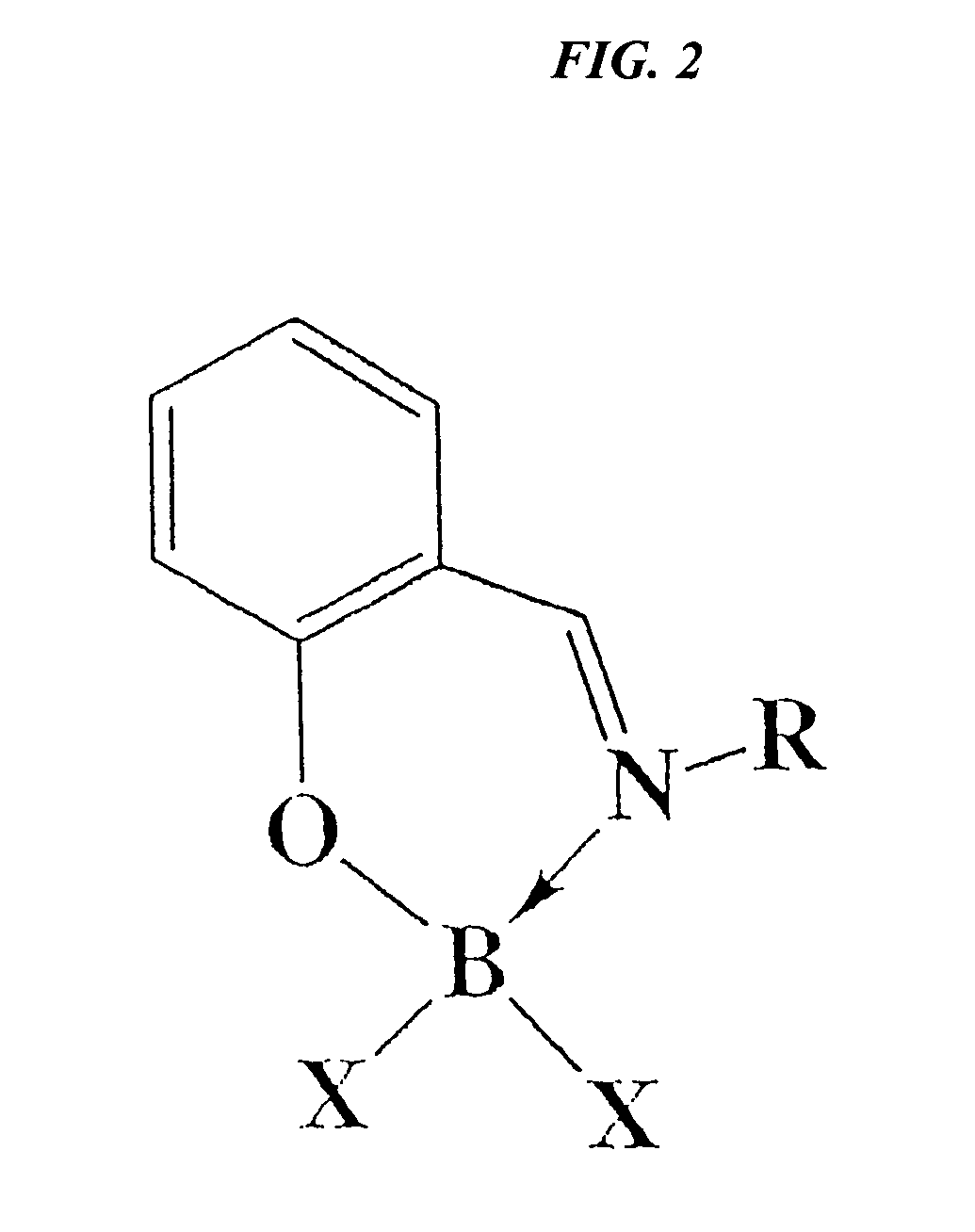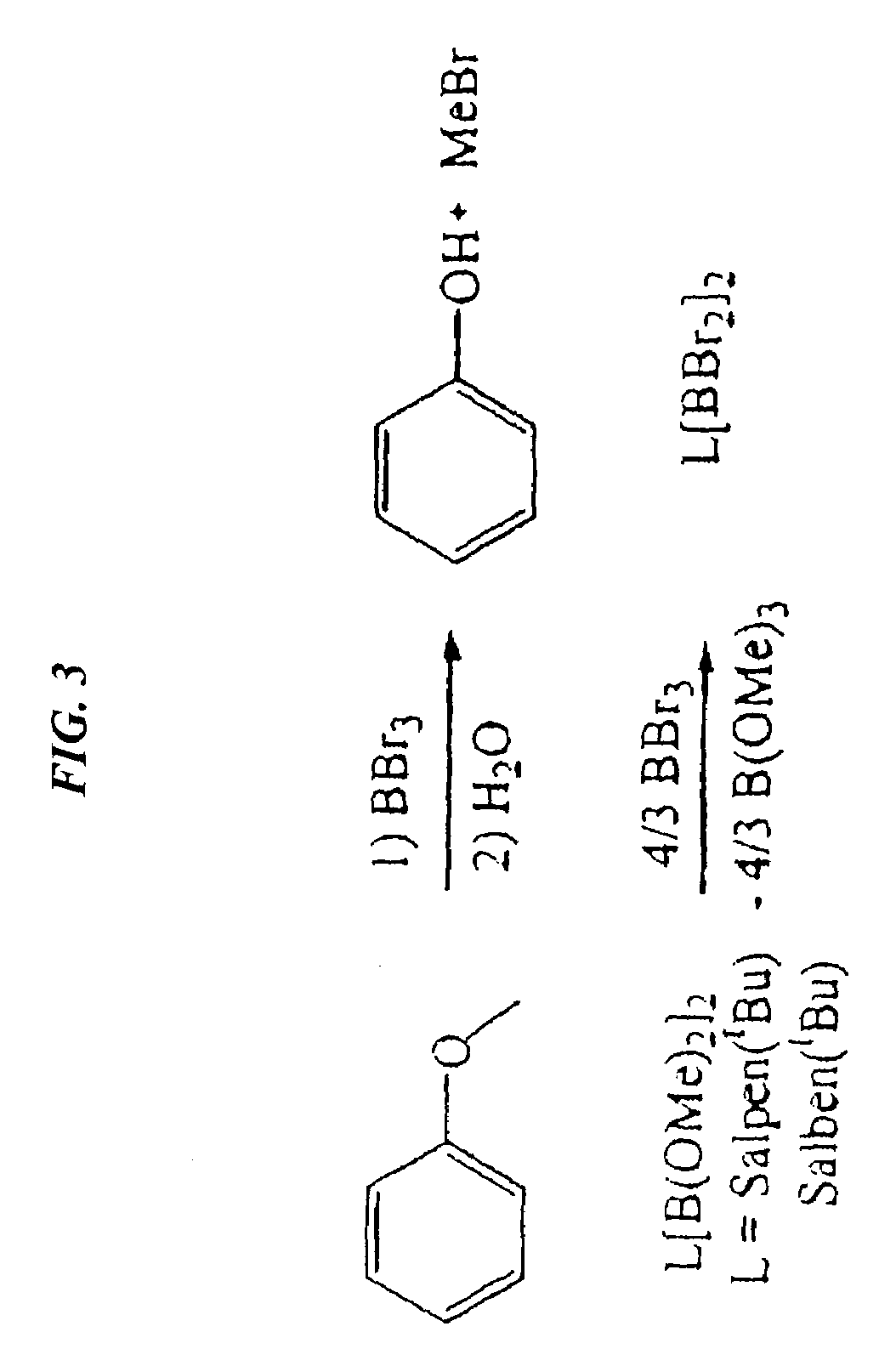Catalytic cleavage of phosphate ester bonds by boron chelates
a boron chelate and catalytic technology, applied in the field of boron chelate catalytic cleavage of phosphate ester and ether bonds, can solve the problems of affecting the neurological function of cells, bases and bleaching, and undergoing undesirable and potentially explosive side reactions
- Summary
- Abstract
- Description
- Claims
- Application Information
AI Technical Summary
Benefits of technology
Problems solved by technology
Method used
Image
Examples
example 1
Preparation of Salpen(tBu)(BBr2)2
[0027]Binuclear boron bromides were prepared in high yields by combining Salpen(tBu)[B(OMe)2]2 or Salben(tBu)[B(OMe)2]2 with a stoichiometric amount of BBr3. To a stirring solution of Salpen(tBu)[B(OMe)2]2 (3.0 g, 4.62 mmol) in toluene (50 ml) was added 1 M BBr3 in heptane (6.24 ml, 6.24 mmol). The reaction mixture was stirred for 24 hours, and the solvent removed. The remaining solid was washed with 10 ml of hexanes, and filtration and vacuum drying yielded 3.28 g (88% yield) Salpen(tBu)(BBr2)2.
example 2
Preparation of Salben(tBu)(BBr2)2
[0028]To a stirring solution of Salben(tBu)[B(OMe)2]2 (1.0 g, 1.51 mmol) in toluene (50 ml) was added 1 M BBr3 in heptane (2.04 ml, 2.04 mmol). The reaction mixture was stirred for 18 hours at room temperature. The solution was concentrated to 10 ml, filtered, and dried. The yield was 0.96 g (76% yield) Salben(tBu)(BBr2)2.
[0029]NMR analysis showed a broad single peak (at δ−0.57 and −0.40 ppm, respectively) for both binuclear boron bromide compounds prepared as described in Examples 1 and 2, upfield from a related chloride analogue Salpen(tBu)[BCl2]2 (at δ 6.21 ppm).
example 3
Dealkylation of Phosphates with Salpen(tBu)(BBr2)2
[0030]Salpen(tBu)(BBr2)2, prepared as described in Example 1, was evaluated for its ability to dealkylate various phosphate esters. In a NMR tube, phosphate was added to an equimolar solution of Salpen(tBu)(BBr2)2 in CDCl3 and held at room temperature for 30 minutes. The reaction was monitored by 1H NMR. As shown in Table 1, significant dealkylation, measured by the amount of phosphate remaining in the reaction mixture in comparison to the amount of alkyl bromide produced, could be achieved with the composition of the present invention.
[0031]
TABLE 1Percent dealkylation of phosphates with Salpen(tBu)(BBr2)2PhosphateConversion (%)a(MeO)3P(O)89(EtO)3P(O)63(nBuO)3P(O)99(nPentO)3P(O)98(MeO)2P(O)H85(MeO)2P(O)Me99(iPrO)2P(O)H63(PhO)2((2-Et)HexO)P(O)71(Me3SiO)3P(O)98(PhO)3P(O)0aThe percent conversion was determined by the amount of phosphate remaining to the amount of alkyl bromide produced in the 1H NMR.
PUM
| Property | Measurement | Unit |
|---|---|---|
| chemical | aaaaa | aaaaa |
| temperature | aaaaa | aaaaa |
| compositions | aaaaa | aaaaa |
Abstract
Description
Claims
Application Information
 Login to View More
Login to View More - R&D Engineer
- R&D Manager
- IP Professional
- Industry Leading Data Capabilities
- Powerful AI technology
- Patent DNA Extraction
Browse by: Latest US Patents, China's latest patents, Technical Efficacy Thesaurus, Application Domain, Technology Topic, Popular Technical Reports.
© 2024 PatSnap. All rights reserved.Legal|Privacy policy|Modern Slavery Act Transparency Statement|Sitemap|About US| Contact US: help@patsnap.com










